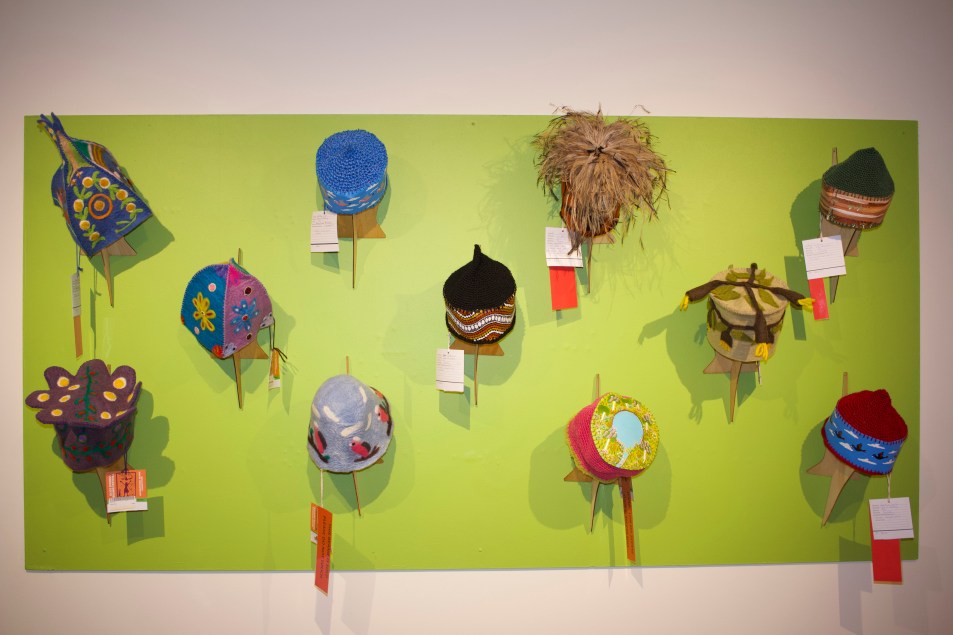
What do you look for in a beanie? Shape? Height? Stitch style? No. It’s colour, says Jo Nixon, “chief beaniologist” of the Alice Springs Beanie Festival.
“A combination of green, pink, purple and a bit of red,” Nixon tells Crikey while wearing an Indigenous- made white felted hat with red embellishments. “Whether it’s felted, crocheted or knitted, it doesn’t worry me.”
The annual Alice Springs Beanie Festival has just wrapped up its 27th year with 4833 beanies sold for $219,000. Although slightly less than last year’s 5433 for $230,235, the 2023 festival broke records for the most beanies sold in a single day: 2324 for $108,660.

Spread over four days at the Araluen Arts Centre in Mparntwe (Alice Springs), the festival showcased and sold — either on the “Beanie Central” market floor or in the exhibition and competition space — hand-made headwear by national and international beanie makers.
Beanie Central was a hive of humans and beanies: tables piled up with crocheted, knitted and felted creations, makeshift walls with hats pinned to them, and drop-down editions from the ceiling. Among the 6500 beanies for sale, no style was spared: berets, balaclavas, sunshades, ear flaps, wraparounds and many stylistic add-ons.

There was headwear for every human who walked through the door — approximately 5000 — and it was common to see people with two beanies on their head and three or four in the hand.
Prices in Beanie Central ranged from $5 to $120, with an average of $45. Move into the exhibition space, and they cost up to $2000.

These creations channel stories and scenes into a hat, with big contributions from Indigenous communities including Ali Curung, Tennant Creek, Amplatawitja, Canteen Creek, Titjikala and Ernabella. Nixon says about 100 beanies from Indigenous women feature in the festival and 11 women from Ali Curung and Titjikala who made the trek in to teach beanie making in-house.
The festival is rooted in Indigenous beanie culture in community, with founder Adi Dunlop first making inroads in Yuendumu 26 years ago. She was there in 1997 to teach numeracy and literacy to Indigenous women but spent her lunch breaks crocheting beanies. The ladies said, “That looks better than numbers and words, we want to do that too,” and so Dunlop taught them to crochet.

Nixon recalls Dunlop coming back to town with 100 beanies. They decided to hire a venue, recruit a band, cook up some pumpkin soup, hang the headwear from the roof, and collectively learn to crochet.
Nixon says the calibre of creations has grown exponentially ever since: “For beanie festival number two or three, I made a rainbow-coloured beanie that won best use of colour. Now that beanie wouldn’t even sell in Beanie Central, let alone get a look in the competition. The beanies are beyond extraordinary.”
Between Nixon and her festival partner Kris Malinski (who’s been in the game for 10 years), they’ve had hands on every beanie that’s come through the door. She says she knew the people’s choice the moment she opened the box. That hat is a felted number with two hikers on the Larapinta.
Other prize categories include “Mrs Haggies Spirit of the Land”, “A Famous Family Adventure”, “The Great Australian Road Trip”, “The Embellishment” and “Memories of your Favourite Country”.
The proceeds from beanie sales go into Indigenous beanie making workshops (70%) or back to makers (30%). Any beanies that don’t sell are divvied up based on their practicality. In the same vein, those deemed functional and wearable are donated to Indigenous communities and organisations. The rest are packed up and “returned to sender”. Then begins preparations for Beanie Festival 2024 where there are plans to give a little more headspace to a beanie compatriot: the tea cosy.
For Nixon, it’s a year-long endeavour. And despite the many, many beanies that pass her by, she confesses it’s a simple crocheted number with little bits of wool hanging off the back that’s stood the test of time: “It’s boring as batshit but whenever I wear it people go ooh and ahh.”








Makes a change to hear happy stories emerging from the Territory. I think we dwell on the negative a little too much.
Congralutations Jo. Another success.
Thanks Crikey for recognising this iconic festival. It’s such an antidote to our toxic urban culture.
This well established national festival is a celebration of Aboriginal women, mainly by women from across mainstream Australia. Long may it prosper